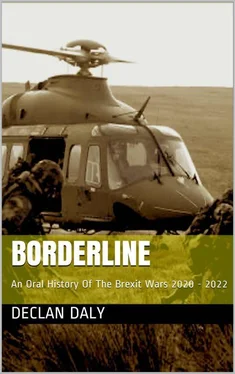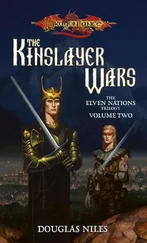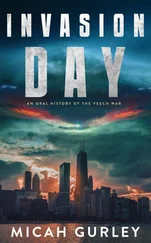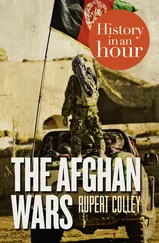Seperately, the Royal Navy carrier Queen Elizabeth continued it’s undisclosed operations off the south west coast. It was normal, not to broadcast what they were doing, but under the circumstances people were more aware of the ships presence than might otherwise be the case.
But offshore and out of sight of land from the furthest west point of Kerry was along way from Donegal. It was in Ireland’s most northern county that the Carsonites, reduced in number and also tired from continuous fighting, decided to force the issue and seek to bring the war to a close on their terms. On the night of the first of July 2022, the Carsonite forces invaded the Republic of Ireland.
◆◆◆
Senator Ian Davis
‘Militarily, we talk about key terrain. If you look at where Finner is, not far into the bottom of Donegal, the key terrain is to the North. First you come to the Bluestack Mountains, this chain starts in the East in Northern Ireland and runs West all the way to the coast. It is the dominant high ground splitting southern Donegal from the northern expanse of the county and Letterkenny town, the biggest population centre which was positioned about half way up. Letterkenny is itself at the bottom of Lough Swilly, a deep water fjord and also important coastal territory – much of the weapons that came in crossed Lough Swilly into the North, not including of course rumoured submarine activity.
The vital areas here were Letterkenny town as the biggest population centre, Killybegs as a major economic engine for the county and also a militarily important port in it’s own right and the airport. All of these were north of the Bluestack Mountains and specifically, north of the Barnesmore Gap. This gap, which was in sight of Finner on a good day, was the gateway for the North of the county. Hold the gap and you hold the north. It consisted of a comparatively narrow, steep sided pass in the mountains with a river, a road and some phone lines at the base. Even the heli pilots treated it as a choke point, on the grounds that having to go around it by the coast, you might run out of fuel before you got back inland to your destination.
Of course, we weren’t idiots, we knew this. In a previous life, I myself served in the Coy strength detachments in Rockhill, near Letterkenny and Fort Dun Ri, further north again but these were gone now, along with all the other outposts that disappeared in the 2012 reorg. They had been replaced as much as we could with Starfort 36 which sat just to the north of Barnesmore Gap itself, and the ATCP platoon in Letterkenny for Garda support along with the Reserve platoon in the airport and the regular platoon in Killybegs. In terms of fixed installations, that was it. It was always a case that counter insurgency operations in Donegal would have a focus on patrolling. The numbers required to permanently base enough troops all around the county and monitor every bit of activity from fixed positions would have used up the whole army. Instead, extensive use of helicopter borne airmobile patrolling was employed along with normal ground based patrolling and checkpoints.
The fact of the matter is, Donegal had been comparatively quiet, when you compare it to other areas of the border where the fighting was heaviest. It may be that the Dissidents didn’t want to increase the heat in the area, when it was so vital to their resupply efforts – heavier combat would certainly have brought more attention to them there. It wasn’t that we weren’t doing everything we could to interdict wepons already, it’s that we were still stretched thin. If the fighting was in the East and you have a finite amount of people and equipment, that’s where it had to go.
Donegal became a place where, so much as we could, we sent new Lts, new Ptes there first to cut there teeth before throwing them into the fight. It wasn’t always possible but it was observable that those personnel had a lower attrition rate than ones who had their first detachment in Starfort 4 or the Sliabh Blooms for example. In short, apart from Finner in the South of the county, Donegal was low on numbers and experience for the size of the county. Troops mounted their patrols by helicopter into the northern parts of the county, with the occasional amphibious landing around the coast with the Naval Service just to keep everyone guessing. It was often littered as well with recce troops and ARW on longer term patrols monitoring suspected supply lines, but these were often intelligence lead operations – if the enemy air activity picked up, we knew arms were coming in one way or another and we would deploy them then, otherwise high end experienced troops were needed elsewhere.
Many questions have been asked as to why we didn’t do X,Y or Z to put more troops into Donegal. People putting these suggestions forward typically have no idea how long it actually takes to reinforce and rebuild an Army once it has been run down in numbers – it’s more than just rushing people through six months of recruit training. The experience of the leadership on the ground is critical, the NCOs and junior officers. Even with years of combat now under our belt, and the re-entrants with overseas experience, the more we grew, the thinner the experience was spread. It was a direct consequence of the accelerated process we were forced to employ, a risk we knowingly took. We certainly reaped the consequences. It must also be remembered, that no one was expecting an attack like this, not even the Russians. Even the Carsonites didn’t expect it to work out like it eventually did. What they envisaged as a large scale raid, turned into multiple smaller actions of their own and then into a rout.
That complete surprise that they achieved on the first day and their actions, as viewed by us on the outside of their command element, meant that in the ensuing political panic, notions were entertained about British intentions that even now at this short remove seem outlandish, but which at the time were plausible. That the British government were also taken by surprise and were… uncommunicative, did not help. Moving their carrier further North instead of clearing the combat area; almost certainly it was what they said it was, merely an attempt to keep an eye on events but it looked like an aggresive move.
It was seen as unlikely, but what if the mood towards the Carsonites had changed and now they had air support from carrier launched stealth fighter? The one percent chance possibility meant it couldn’t be ruled out which lead to the next question. What would the French do? They had signed on for a peacetime air policing effort, not a confrontation with F 35s from a NATO state with all the Article 5 implications that might have. Would they still police the air environment under those circumstances? Which lead straight to the follow up – our own fighter fleet was brand new and not yet equipped for air to ground operations, would the French assist in that arena, one that was clearly outside the original agreement. This took tense negotiation over several crucial days.
Add to this the fear of further bombings in Dublin and elsewhere, and the increasingly acrimonious tension within the British Govt itself regarding both the war in the North and the Scottish independence movement, all of which was being played out in the media. Yes, the mood was certainly tense. Fearful. Febrile. Wrong moves either at the tactical level or the political level, in any of the relevant capitol cities, could have lead us all to a violent place we didn’t want, or intend to be.’
◆◆◆
The Carsonite attack into Donegal opened up with a heavy rocket barrage onto Starfort 36. The platoon there, the fort was understrength compared to its design, were overwhelmed by a mix of hi explosive and thermobaric warheads. Any that survived the first, were killed by either the blast, heat or suffication effects of the latter. This effectively opened the door into northern Donegal and the left out patrol was quickly snapped up by the mobile forces that followed on the heels of the last rocket. Estimates vary, but most say that as many as five hundred Carsonite fighters, riding on four wheel drive vehicles that were themselves equipped with machine gun, rocket and mortar support weapons, entered the area North of the Barnesmore Gap and began to spread out.
Читать дальше












